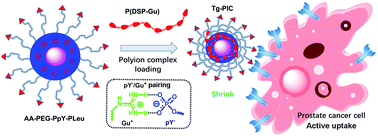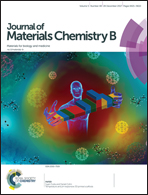Targeted delivery of a guanidine-pendant Pt(iv)-backboned poly-prodrug by an anisamide-functionalized polypeptide†
Abstract
We describe here a novel targeting polyion complex (Tg-PIC) system for the delivery and intracellular release of cisplatin. Briefly, a guanidinium-pendant Pt(IV)-backboned poly-prodrug termed P(DSP-Gu) is prepared with excellent aqueous solubility, high drug-loading and high potency. To enable prolonged circulation and selective cellular internalization, P(DSP-Gu) is complexed with anisamide-end-capped poly(ethylene glycol)-block-poly(L-phosphotyrosine)-block-poly(L-leucine) (AA-PEG-PpY-PLeu) to yield Tg-PIC via electrostatic coacervation. Tg-PIC is stabilized by hydrogen bonding between phosphate and guanidinium, the PEG corona, and the helical poly(L-leucine) segment forming the hydrophobic core. The anisamide group, a high affinity ligand recognizing the sigma (σ) receptors that are overexpressed on many human malignancies including prostate cancer, is incorporated at the surface of the Tg-PIC for active targeting and efficient internalization. In vitro, the Tg-PICs show targeted and efficient internalization into sigma receptor-positive PC3 cells, and can release toxic Pt(II) species due to the degradation of P(DSP-Gu) under the intracellular reducing conditions. In vivo, the Tg-PICs exhibit superior antitumor efficacy with reduced toxicity. Thus, the system holds considerable promise towards more effective and safe nanomedicine.



 Please wait while we load your content...
Please wait while we load your content...